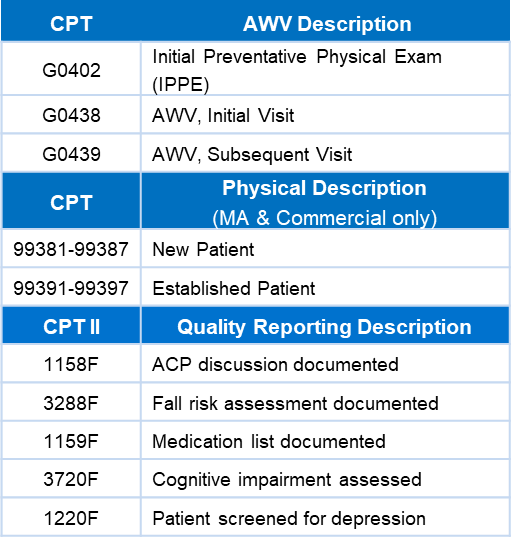
Annual Wellness Visits
Medicare’s Annual Wellness Visit (AWV) is one way for your practice to keep patients healthy. As healthcare moves from volume to value-based models, the AWV is an opportunity to address gaps in care and enhance the quality of care you deliver. A personalized plan created for a Medicare beneficiary can also improve patient engagement and promote preventive health care.
Medicare pays 100% of the AWV. There is no deductible or coinsurance owed by the patient. A problem-oriented visit is not part of this benefit and is subject to deductibles or coinsurance when an Evaluation & Management code is also billed.
AWV Coverage:
Medicare covers an AWV that delivers Personalized Prevention Plan Services (PPPS) for patients who:
- Are no longer within 12 months after the patient’s Medicare Part B benefits eligibility date
- Have not received an IPPE or AWV within the past 12 months
- Medicare does not cover Routine Physical
Although Medicare does not cover a routine preventative physical exam, many Medicare Advantage (MA) plans offer this as an additional benefit every year and it can be done at the same time as an AWV.
CMS does not require you to use a specific AWV diagnosis code, so you may choose any diagnosis code consistent with the patient’s encounter. This is a perfect time to review and address chronic conditions, as it may be the only visit of the year to address the full treatment plan for all chronic conditions.
When you provide an AWV and a significant, separately identifiable, medically necessary Evaluation and Management service, report the additional CPT code with modifier –25.
Documentation & Coding for an AWV
- Administer a health risk assessment (HRA)
- Demographics & self-assessment of health
- Psychosocial & behavioral risks
- Activities of daily living (ADLs)
- List current providers and suppliers of healthcare
- Establish medical and family health history
- Medical, surgical, & family history
- Current medications and suppliers
- Document risk factors for potential depression
- Screen patient for cognitive function
- Review functional abilities and level of safety
- Conduct a general health assessment with vitals
- Document all active chronic conditions and risk
- Counsel the patient
- Discuss and document advance care planning (ACP)

Resources:
About the Author


